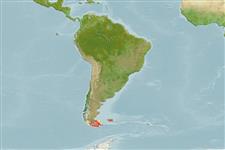Common names from other countries
Classification / Names / Names
Namen | Synonyme | Catalog of Fishes (gen., sp.) | ITIS | CoL | WoRMS
Environment: milieu / climate zone / depth range / distribution range
Ökologie
; tiefenbereich 0 - 105 m (Ref. 83435). Temperate; 19°S - 57°S, 77°W - 55°W
Southeast Pacific and Southwest Atlantic: Argentina, Chile and Falkland Island.
Length at first maturity / Size / Gewicht / Alter
Maturity: Lm ? range ? - ? cm Max length : 8.6 cm DL Männchen/unbestimmt; (Ref. 83435)
This is an intertidal herbivore found on rocky substrates, stones, silt, shell and coral fragments from the lower intertidal areas (Ref. 87801).
Life cycle and mating behavior
Geschlechtsreife | Fortpflanzung | Ablaichen | Eier | Fecundity | Larven
Members of the order Patellogastropoda are mostly gonochoric and broadcast spawners. Life cycle: Embryos develop into planktonic trocophore larvae and later into juvenile veligers before becoming fully grown adults.
Rosenberg, G. 2009. (Ref. 83435)
IUCN Rote Liste Status (Ref. 130435)
CITES Status (Ref. 108899)
Not Evaluated
Not Evaluated
Nutzung durch Menschen
Fischereien: kommerziell
| FishSource |
Tools
Mehr Information
Alter/GrößeWachstumLänge-GewichtLänge-LängeMorphologieLarvenDichte
Internet Quellen
Estimates based on models
Preferred temperature
(Ref.
115969): 6.2 - 7.9, mean 7.2 (based on 26 cells).
Preiskategorie
Unknown.
